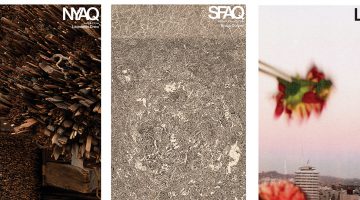“Alluring Tensions”
By Wendi Norris
It’s unclear if Jason Brinkerhoff is foremost a collector, a curator, or an artist. He intuitively walks a fine line between a fetishistic, boundary-pushing outsider, and well-educated artist with an ability to weave fragmented pieces of art history into his own work. Brinkerhoff’s source imagery fills his vast studio, located twenty miles south of San Francisco in a row of vintage auto body shops. Orderly stacks of Italian “Vogue” magazines from the 1970s, an entire estate of Polaroid head-shots of beautiful TV stars from 1969-1972, and meticulously sorted vernacular photography collected from renowned dealers, online sources and flea markets take up much of the space. There is undoubtedly a kinship with the relentless vanguard artist Miroslav Tichý (Czech, 1926-2011), whose voyeuristic photographs of women in the 1970s were heralded by ArtForum as being “singularly responsible for inventing photography.” Brinkerhoff obsesses over the hundreds of fragmented images. “It’s something like a dance with the drawings. I can pluck from any of the hundreds at a moment’s notice.”
Although Brinkerhoff employs a variety of inventive and experimental techniques, he remains singularly focused on images of women. He dissects his subjects, often rendering the head and body separately. Paradoxically, the forms are tenderly drawn with his melodic charcoal line, and colored with a playful array of wax pastel, oil, acrylic and even spray paint. Always collaged onto antiquarian paper, these female forms are revealed in singular or narrative arrangements of intimate, beautiful or erotic poses. All are untitled, as if he is distancing himself from his subject.
According to Matthew Higgs, the White Columns Director who discovered the thirty-eight year old Brinkerhoff as an artist, “Jason obsessively reworks his images; often times producing hundreds of drawings inspired by one simple pose in a Picasso painting. It’s as if he is curating an image, drawing from historical references, or from his own point of view, allowing all of these histories to co-exist.”
In 2012, Higgs gave Brinkerhoff his first solo exhibition at White Columns, New York City’s oldest alternative non-profit space, founded in 1970, for up and coming artists. The show, entitled “Some Women,” traveled to ZieherSmith in Chelsea where it was touted as one of the best shows of 2012 by “Modern Painters” and all 77 drawings quickly found collectors.
Even as Brinkerhoff employs a collector’s eye towards editing his own work, his personal collection accumulates. In “Other Bodies” (2012), Jason curated an exhibition of 65 found photographs from a series of 2,000 at ZieherSmith. In the Wall Street Journal’s review of the show “presumably all were taken by amateurs but they sometimes exhibit effects that professionals would find hard to duplicate.”
Jason Brinkerhoff’s work evokes an alluring tension. He remains removed from his subject, as opposed to Tichý or even street photographer Gary Winogrand, yet he is determined to mine the mysteries of the female form, and perhaps, the female psyche. Is it an appreciation of beauty or a form of misogyny? The moment the images touch the high quality paper hand-picked from books printed in the 1920s-50s with titles like “Goya”, “Italian Painting”, and “The Davanzati Palace” the figures become canonized. The women placed atop a pedestal.
With San Francisco’s Jason Brinkerhoff, the art world is once again presented with a multidisciplinary art practice, but this one uniquely crosses the vast and prevalent art world divide between collector, curator, and artist.
For more information on Wendi Norris visit Gallery Wendi Norris, San Francisco.
This interview was selected from issue 13 of SFAQ.






